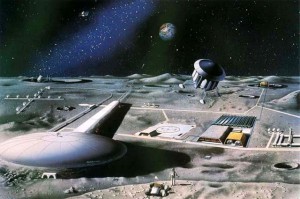Oct
23
Water on the Moon
“Do I gotta get water from the Moon?
Is that what I gotta do to make you love me?”
Good news, Celine! It’s there! (No green cheese, yet, though.)
It all began last year, when NASA’s LCROSS Mission crashed a spent-fuel, Centaur rocket into a lunar crater at 5,600 miles an hour — on purpose. (See video below of a commemorative song from one of the deputy project managers.) A couple of satellites observed from lunar orbit and began doing chemical analysis of the roughly 8800 pounds of material kicked up by the impact. Eureka! The debris, as announced last November, included significant amounts of water, along with ammonia, methane, hydrogen, carbon monoxide, mercury, & various minerals. Even a little silver.
 The crater of interest is Cabeus, near the southern pole, which was chosen “because it is so deep that sunlight never reaches the bottom — and any ice there, mixed in the soil, would never have a chance to vaporize.” So, by focusing on one of these “cold-trap” regions, the odds were in their favor.
The crater of interest is Cabeus, near the southern pole, which was chosen “because it is so deep that sunlight never reaches the bottom — and any ice there, mixed in the soil, would never have a chance to vaporize.” So, by focusing on one of these “cold-trap” regions, the odds were in their favor.
Now, several research papers being published in Science report on the more detailed analyses of the data that have been ongoing. Conclusion: We’re looking at about a billion gallons of water! Enough to fill 1500 Olympic-size swimming pools! That’s twice what is estimated to be in the Sahara Desert! (Didn’t know there was so much water in the Sahara, didja?) And that’s just one crater….
“The quantity of water discovered was 50% greater than NASA’s initial estimates. Other measurements suggest there’s even a ‘lunar permafrost’ covering about 30% of the southern polar region of the moon, with ice lying just below the surface.”
Brown University’s Peter Schultz expressed his amazement to ABC News, saying:
“This place looks like it’s a treasure chest of elements, of compounds that have been released all over the moon and they’ve been put in this bucket in the permanent shadows.”
In his Wall Street Journal column, Gautam Naik makes the point that,
“The presence of water doesn’t make it more likely that there ever was life on the moon, as the location studied is among the coldest in the solar system.”
Great point. Of course, there are MANY, many other reasons why life could not have originated or survived on the Moon. But, that’s a topic for another day.
The presence of H2O in relatively large amounts does give hope to the hopeful (such as myself), however, that a manned lunar base may be in our future. Water, after all, is an essential requirement for man’s survival. Transporting water to the Moon would be VERY expensive, such that a bottle’s worth would cost about $50,000. So, if there is a local source, it represents a big “pro” in the argument for establishing such a base.
Of course, there is no liquid water on the Moon. As indicated above, it is all in the form of ice and makes up about 5.6% of the crater’s soil, according to Anthony Colaprete of the NASA Ames Research Center. (2200 pounds of moon dirt –> a dozen gallons of H2O) The ice crystals would have to be extracted from the soil and run through a purification process to remove the other (sometimes deadly) substances, before it was potable. The water could be used as a coolant, as well, for spacecraft systems and other machinery. It could also be broken down into oxygen (which could be used for breathing) and hydrogen (which could be used for fuel). In fact, the molecular hydrogen that was found in the soil could also be heated up for rocket fuel.
Another hurdle to overcome, though, is the current administration’s decision to axe the Constellation program. That project, approved by President Bush, would have returned astronauts to the Moon by the end of the decade and eventually sent them to Mars. This move has already put us behind other countries (e.g., China, India, & Japan), which have plans to establish their own presences on the Moon.
Still, the water discovery is intriguing and encouraging, and it should prove exciting to watch how things develop as the technology improves and our knowledge increases.
















